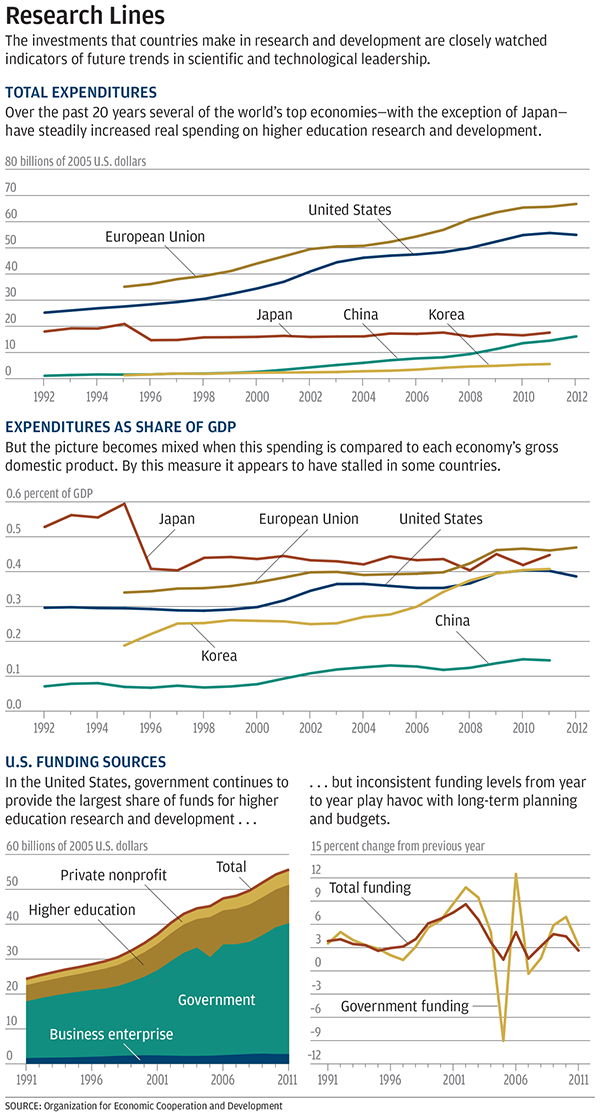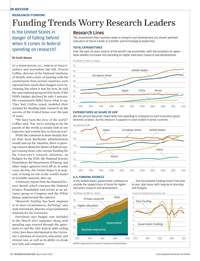In Review
At a Washington, D.C., forum of policymakers and journalists last fall, Francis Collins, director of the National Institutes of Health, told a story of meeting with his counterparts from several countries: each reported how much their budgets were increasing, but when it was his turn, he told the international group he’d be lucky if the NIH’s budget declined by only 5 percent. His counterparts didn’t know what to say. They had, Collins noted, modeled their systems for funding basic research on the success of the United States over the past 75 years.
“We have been the envy of the world,” Collins said, “but we’re starting to be the puzzle of the world as people look at our trajectory and wonder how we lost our way.”
While the comment is more sharply stated than most Rochester administrators would sum up the situation, there is growing concern about the future of federal support among those who oversee funding for the University’s research initiatives. As budgets for the NIH, the National Science Foundation, the Department of Energy, and other major agencies level off or, in some cases, decline, the United States is in jeopardy of losing its role as the world’s leader in scientific research, they say. A February report from the National Science Board, which oversees the National Science Foundation and serves as an advisory group to Congress and the White House, underscored the concern.

“Research funding has been stagnant or in most circumstances, declining,” says Josh Farrelman, director of governmental relations for the University. Farrelman says budget cuts included in the March 2013 sequester, along with spending caps enacted through the agreement to end the 2011 federal debt-ceiling crisis, have been detrimental to the University’s missions of research, education, and clinical care, as well as its ability to create new jobs and companies.
Going into 2014, the situation has steadied a little bit, he says, thanks to a bipartisan budget act passed by Congress last December. But while the two-year budget provides some relief, it falls short of restoring agencies like the NIH and NSF to pre-recession levels, and it reduces the effects of the sequester on the agencies’ budgets by only 25 percent for the 2015 fiscal year.
The result is that researchers at Rochester and other universities will find it increasingly difficult to win funding for their projects, says Rob Clark, senior vice president for research and dean of the Hajim School of Engineering & Applied Sciences.
“The competition has become even more fierce for an even smaller pot of money,” Clark says. “It’s important that we try to increase the budgets that fund the federally sponsored research agencies that we care very dearly about. If we’re able to increase the overall pot, we will be able to, we think, compete very well for funding.”
Rochester can claim considerable success in earning federal and other outside support. Over the past five years, the University has received nearly $2 billion in research funding, the majority of which comes from federally sponsored research agencies, including the NIH, NSF, Department of Energy, and Department of Defense. On a per faculty basis, the University ranks among the top 15 institutions in the country.
Clark says the funding is important not only because it keeps Rochester at the forefront of research but also because of the way University-based research resonates throughout the economy.
“We have a strong history of leveraging federal funds to develop technologies and research that have had not only a national impact, but also a global impact,” Clark says, noting Rochester’s work in vaccine development, optics, medical imaging, and other areas. “We’ve also created 56 spinoff companies since 1996.”
Although the NIH traces its roots to the late 19th century, it wasn’t until the end of World War II that it took on its current role as one of world’s leading funding sources for biomedical sciences. In 1950, Congress established the NSF as an independent federal agency “to promote the progress of science; to advance the national health, prosperity, and welfare; to secure the national defense.”
The agencies and other federal programs modeled on them are credited with spearheading many of the technological, scientific, and clinical breakthroughs of the second half of the 20th century. The NIH alone traces more than 80 Nobel Prizes to research conducted by NIH–funded scientists.
That scientific infrastructure has been a key component of the nation’s economy, says Farrelman.
“Most economists agree that at least 50 percent of economic growth in the United States over the last half of the 20th century is a consequence of technological innovation, much of which results from federally funded scientific research,” he says.
That’s why it’s troubling to see the agencies in danger of losing their international standing, he says.
According to statistics gathered by the Organization for Economic Cooperation and Development (OECD), spending on research at higher education institutions in the United States increased from about $31 billion in 2000 to about $63 billion in 2012. But since 2010, the total has leveled off, going from $60.4 billion in 2010 to $62.5 billion in 2011 to $62.7 billion in 2012.
As a percentage of the nation’s GDP, U.S. support for research and development in higher education has gone from about 0.30 percent of GDP in 2000 to about 0.39 percent in 2012, according to the OECD. (For purposes of comparing across categories of data, the figures in the accompanying charts are in constant 2005 dollars.)
As countries like China, Korea, and Singapore emphasize the importance of research and development to their economies, they have increasingly invested in programs similar to those in the United States, and many of them are growing rapidly. For example, according to OECD figures, China has gone from spending $2.3 billion on higher education research and development in 2000 to about $18.5 billion in 2012. As a percentage of GDP, Chinese support has gone from 0.08 percent in 2000 to 0.15 percent in 2012.
“It’s important to look at the overall trajectory of federal investments in research and put it into context of what’s happening internationally,” says Clark.
He says that as Rochester and other U.S. universities have been at the forefront of research for the past several decades, the world’s top researchers and scientists often looked to the United States for their education, and usually stayed to launch their careers and build up their labs.
“That’s still the case, but now we’re trying to attract and keep the best and the brightest in a world where China, Singapore, South Korea, and other countries are making double-digit investments,” he says. “They’re competing with us to keep those folks in their own country or bring them home. It’s always been a competitive environment, but the competition has stepped up.”
Despite the tightening of federal budgets, Farrelman says there have been notable successes. In particular, the Laboratory for Laser Energetics received $64 million in the recently approved 2014 spending plan. That’s about $5.25 million more than the $58.75 million allocated to the lab last year under sequestration.
But that was a small bright spot in the overall, international picture, he says.
“One of the main reasons countries like China and Singapore are investing so heavily is because they are trying to replicate not only major research institutions like Rochester, but also agencies like the NIH,” he says. “They know that our process works and drives innovation and economic growth.”
Says Clark: “I think everyone involved in research leadership at Rochester is keenly aware of how competitive the environment is and how tough the political environment is. We are very engaged in an effort to keep Rochester at the forefront of scientific research.”

